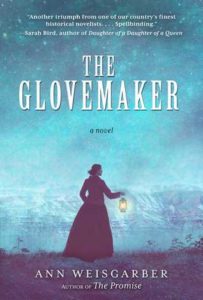 Ann Weisgarber discusses the inspiration for her third novel, The Glovemaker, and whether it’s her story to tell. It is published by Skyhorse Publishing in the United States, Mantle/Pan Macmillan in the United Kingdom, Nagel & Kimche in Germany, and Neri Pozza in Italy.
Ann Weisgarber discusses the inspiration for her third novel, The Glovemaker, and whether it’s her story to tell. It is published by Skyhorse Publishing in the United States, Mantle/Pan Macmillan in the United Kingdom, Nagel & Kimche in Germany, and Neri Pozza in Italy.
I’m a Catholic, not a member of the Church of Jesus Christ of Latter-day Saints. I grew up in Ohio, not Utah. I’m a city gal rather than a farmer. Yet, most of the characters in my novel, The Glovemaker, are Latter-day Saints. The story takes place in what is today’s Capitol Reef National Park in Utah during 1888. The two narrators, Deborah and Nels, are orchardists in a small isolated community.
Some might say The Glovemaker isn’t my story to tell. On the surface, I have nothing in common with the characters and the setting. Writers are often told to write what they know. I understand this. Yet, I made the decision to write what I didn’t know but what I was compelled to explore.
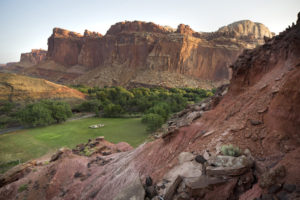
It all began when my husband and I spent a vacation at Capitol Reef National Park. The park is an untamed landscape of steep cliffs, looming rock formations, narrow canyons, and massive domes made of sandstone. It was also home to a handful of white settlers that planted orchards in the shadows of the cliffs. Today, the orchards are maintained by the park service.
During our vacation, I wandered through the orchards, my thoughts popping with questions. Who were the people who planted the original trees? Why did they come to this place of towering rocks? What made them happy? What broke their hearts?
Curious, I bought several books at the park’s visitor center. Information about the early white settlers was sketchy but evidence indicated that the first to successfully stake a claim was an unmarried man in 1880. During the next three years, seven to eight families trickled in. All were members of The Church of Jesus Christ of Latter-day Saints, and one man had two wives. They settled along the Sulphur Creek and the Fremont River, dug irrigation ditches, and planted fruit trees. They called their town Junction which today is known as Fruita.
One of the settlers was a married woman who owned land in her own name. She didn’t have any children and when I took a closer look, I realized her husband had disappeared from historical records. There wasn’t a gravesite or death certificate for him, and after 1880, he wasn’t in any more census records.
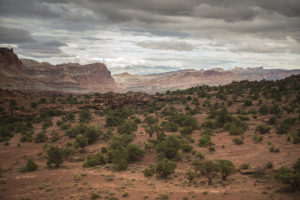
I couldn’t stop thinking about her. Something must have happened to her husband. Maybe he had had an accident that no one witnessed. Or it could be he abandoned her. I couldn’t imagine how she managed a homestead by herself. I wondered if she went to bed each night thinking that tomorrow would be the day her husband came home.
After the vacation was over, I did more research which took me to unexpected places. Junction, it seemed, never had a wardhouse and none of the men ever served as bishop. Apparently, most of the settlers weren’t as devout as might be expected. But what truly surprised me was the discovery that during the 1880s the federal government made an all-out effort to arrest men who had plural wives. Some of these men evaded arrest by hiding in the deep canyon country. One of these places was Floral Ranch about eight miles from Junction. Research suggested that the people of Junction helped these men as they passed through on their way to Floral Ranch.
This captured my imagination. What happened when a man charged with a felony showed up in Junction in desperate need of help? What was it like when deputies arrived searching for the men who were on the run? Most of all, what could cause the barrier between enemies to crumble? When might someone lose the label of enemy and be perceived as a human being?
I can’t point to the exact moment but I was almost finished writing my second novel when I decided the Utah story, as I called it, would be my next book. I couldn’t shake the settlers from my mind, and I knew I wouldn’t have any peace until I put pen to paper. It’s odd to say but it felt like the story had found me and that I didn’t have a choice but to write it.
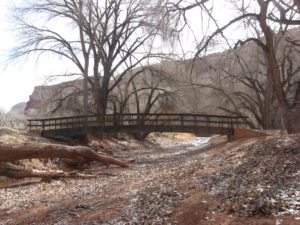
I spent four years writing and researching the book. I returned to Capitol Reef and stood midway on a footbridge over Sulphur Creek. I thought about the symbolism of a bridge and how once you crossed to other side, there wasn’t always an easy return to the familiar. I visited gravesites of some of the Junction settlers and thought about how courageous they were to live in a beautiful but harsh terrain. I stood among the cabins and barns at Floral Ranch, and in the wind I heard the whispers of the people who sought sanctuary.
I walked among the fruit trees and asked myself if I was up to the task of writing The Glovemaker. It could be the settlers asked themselves if they were up to the task of making a home in Junction. I didn’t know if I could pull it off but I had to try. I felt a personal obligation to the people of Junction to give them a voice.
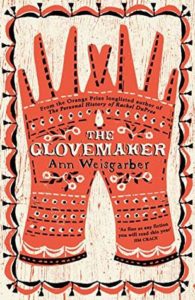 Their experience is the American experience. Their desire for religious freedom, their quest for a home in an isolated landscape, and the disappearance of one of the settlers is a story, I believe, that resonates with many of us.
Their experience is the American experience. Their desire for religious freedom, their quest for a home in an isolated landscape, and the disappearance of one of the settlers is a story, I believe, that resonates with many of us.
On the surface, I have nothing in common with my characters or the historical events. What I do share, though, is the human experience of emotions – love, fear, happiness, heartbreak — that binds each of us.
Is The Glovemaker my story to tell? I leave that to readers to decide.
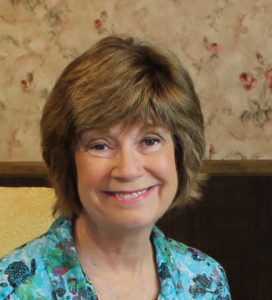 Ann Weisgarber is the author of three novels: The Glovemaker, The Promise, and The Personal History of Rachel DuPree. She won the Stephen Turner Award for First Fiction and the Langum Prize for American Historical Fiction. She was a finalist for Scotland’s Walter Scott Prize for Historical Fiction and the Orange Award for New Writers in the United Kingdom.
Ann Weisgarber is the author of three novels: The Glovemaker, The Promise, and The Personal History of Rachel DuPree. She won the Stephen Turner Award for First Fiction and the Langum Prize for American Historical Fiction. She was a finalist for Scotland’s Walter Scott Prize for Historical Fiction and the Orange Award for New Writers in the United Kingdom.
Ann earned a Bachelor of Arts in Social Work from Wright State University in Ohio and a Master of Arts in Sociology from the University of Houston. She was inducted into the Texas Institute of Letters in 2014 and lives in Galveston, Texas.
Reviews:
Publisher’s Weekly (Starred): Weisgarber’s marvelous third novel is set in the rugged canyon country of southern Utah during the winter of 1887–1888 as a Mormon woman struggles to hold her faith in the face of religious persecution and her fear of the law. Deborah’s husband is overdue to return from a trip, having left her alone in the remote hamlet of Junction, Utah Territory, a collection of eight Mormon families living their faith as each sees fit. One winter night, a stranger arrives at Deborah’s cabin asking for help, speaking in a code that she knows means he’s a polygamist running from the law. He is pursued by a U.S. marshal, and, despite her fear, Deborah hides him, then passes him on to her brother-in-law, Nels, to guide to safety. A tense encounter between the marshal, Nels, and the stranger results in an act of violence and reveals that there’s more to the marshal’s pursuit of the stranger than meets the eye. The moment of violence rocks and divides the small Mormon community; when two more strangers arrive, Deborah and Nels must protect their faith and their community without further violence, while dealing with tender feelings for each other. This is a rich, powerful, and wholly immersive tale grounded in Utah and Mormon history.
AML reviews by Julie J. Nichols and Susan Jensen.

Ann Weisgarber, thanks for this post. It seems to come at a good time, with all the controversy surrounding American Dirt. I think your question “is this my story to tell?” fits in the broader conversation jump started by that other book. I haven’t read your book (or American Dirt), so I can’t comment on either specifically; however, I am of the general impression that if an author approaches a topic from a place of respect and does the necessary research to truly understand the topic, then the story can be told. Authors don’t always do that, and that’s when it’s problematic.
Gabriel, your eloquent comment about this complicated topic gets to the heart of the matter: respect. Thank you.